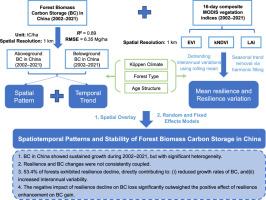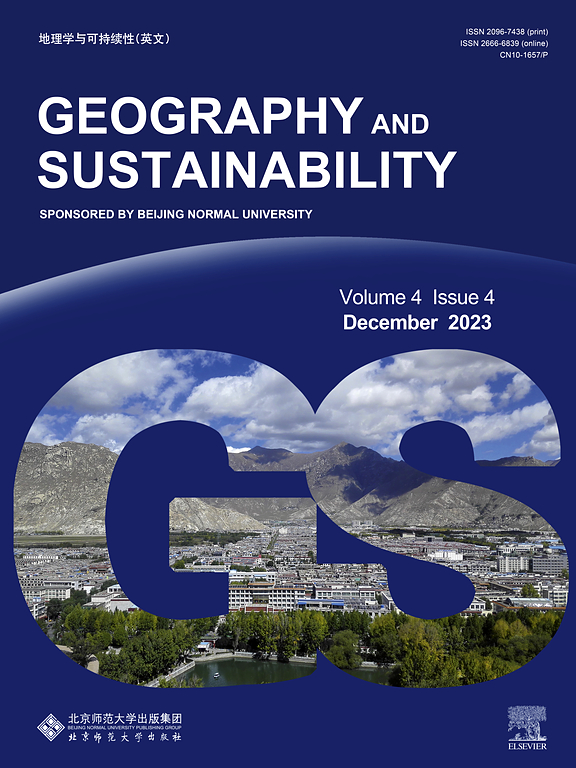2002年以来中国森林生物量碳储量的可持续增长:面临的威胁与损失风险
IF 8
1区 环境科学与生态学
Q1 GEOGRAPHY, PHYSICAL
引用次数: 0
摘要
森林生物量碳储量对减缓气候变化具有重要作用。然而,中国BC生长的时空格局和稳定性尚不清楚。利用2002-2021年最新的BC地图和多源遥感数据,分析了BC的时空动态,并应用弹性指标可靠地评估了其稳定性。我们的研究结果表明,虽然中国的长期森林覆盖率持续增加,但森林覆盖率损失的风险也在加剧,特别是在老林(>;70年),其中大约一半的森林呈现下降趋势。此外,BC动态并不始终与弹性变化一致。约53.4%的森林恢复力减弱,直接降低了23.1%的BC积累率,并放大了年际变率。令人震惊的是,10.4%的森林(BC-,恢复力-),主要是高BC密度森林(平均:28.3 Tg /ha),面临极高的碳损失风险(碳排放量:-118 Tg C)。我们进一步发现,恢复力减弱对BC损失的加速作用显著大于恢复力增强对BC积累的促进作用(-17.79±4.72 Mg/ha vs. 11.47±3.42 Mg/ha)。我们的研究强调,中国的经济增长具有成分不稳定的特点,面临着巨大的损失风险。在今后加强森林碳汇的工作中,应更加重视森林恢复力的变化,以提高生物量碳汇的稳定性,实现可持续的长期碳汇。本文章由计算机程序翻译,如有差异,请以英文原文为准。

Sustainable growth of China’s forest biomass carbon storage since 2002: Facing threats and loss risks
Forest biomass carbon storage (BC) plays a critical role in mitigating climate change. However, the spatiotemporal patterns and stability of BC growth in China remain unclear. Using the latest BC maps (2002–2021) and multi-source remote sensing data, we analyzed the spatiotemporal dynamics of BC and applied resilience indicators to reliably assess its stability. Our results show that while China’s long-term BC has continued to increase, the risk of BC losses has also intensified, particularly in old forests (>70 years), where approximately half exhibit a declining trend. Moreover, BC dynamics do not consistently align with resilience changes. About 53.4 % of forests display weakening resilience, directly reducing BC accumulation rates by 23.1 % and amplifying interannual variability. Alarmingly, 10.4 % of forests (BC-, resilience-), predominantly high-BC-density forests (mean: 28.3 tC/ha), face an extremely high risk of carbon loss (carbon emissions: -118 Tg C). We further found that the accelerating effect of resilience weakening on BC losses significantly outweighs the promoting effect of resilience enhancement on BC accumulation (-17.79 ± 4.72 Mg/ha vs. 11.47 ± 3.42 Mg/ha). Our study highlights that China’s BC growth is characterized by unstable components and faces substantial loss risks. In future efforts to enhance forest carbon sinks, greater attention should be paid to changes in forest resilience to improve the stability of biomass carbon sinks and achieve sustainable, long-term carbon sequestration.
求助全文
通过发布文献求助,成功后即可免费获取论文全文。
去求助
来源期刊

Geography and Sustainability
Social Sciences-Geography, Planning and Development
CiteScore
16.70
自引率
3.10%
发文量
32
审稿时长
41 days
期刊介绍:
Geography and Sustainability serves as a central hub for interdisciplinary research and education aimed at promoting sustainable development from an integrated geography perspective. By bridging natural and human sciences, the journal fosters broader analysis and innovative thinking on global and regional sustainability issues.
Geography and Sustainability welcomes original, high-quality research articles, review articles, short communications, technical comments, perspective articles and editorials on the following themes:
Geographical Processes: Interactions with and between water, soil, atmosphere and the biosphere and their spatio-temporal variations;
Human-Environmental Systems: Interactions between humans and the environment, resilience of socio-ecological systems and vulnerability;
Ecosystem Services and Human Wellbeing: Ecosystem structure, processes, services and their linkages with human wellbeing;
Sustainable Development: Theory, practice and critical challenges in sustainable development.
 求助内容:
求助内容: 应助结果提醒方式:
应助结果提醒方式:


